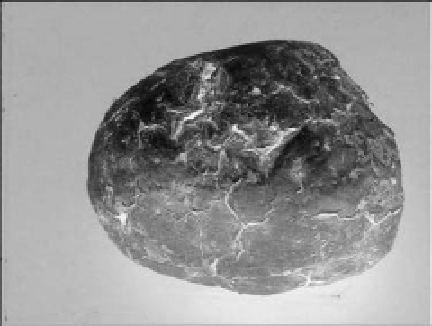Agriculture Reference
In-Depth Information
some species (Boutsika
et al
., 2004; Holeva
et al
.,
2006; Duarte
et al
., 2011).
Potato rot nematode or potato tuber
nematode,
Ditylenchus destructor
Potato rot nematode or potato tuber nematode,
Di-
tylenchus destructor
Thorne, 1945, is widely distrib-
uted in temperate climates; it is found in localized
areas of North America and Europe, the Mediter-
ranean region, and Asia. It has a wide host range
including crops, ornamentals, and weeds, making
control by crop rotation difficult. Potato tuber
nematodes are migratory endoparasites of roots
and tubers. The nematodes enter the tuber through
lenticels, feed, and multiply, rapidly completing
their life cycle in three weeks at
20-
27°C. Dispersal
is primarily via infected tubers, infested soil, and ir-
rigation water, though survival overwintering as
adults, larvae, or eggs is also reported. At temperat-
ures from
15
to 20°C, combined with high relative
humidity, it can be an important pest of potato and
is particularly important for damaging tubers dur-
ing storage if temperatures are not kept low. Potato
rot nematode is a regulated quarantine pest in
many countries.
There are no obvious symptoms on the aer-
ial parts of potato infected with potato rot nema-
todes, although plants may be weak and die.
Infected tubers initially have small, off-white
spots below the peel, which enlarge and darken
and become surrounded by rotten tissue that be-
comes infected with secondary organisms, lead-
ing to general rot during storage. The surface of
the tuber develops slightly sunken areas; the
skin may be wrinkled, cracked, and detached in
places. The decaying tissue may have a discol-
ored and dry, mealy appearance (
Fig. 10.6
).
Several morphological characters are
used to distinguish
D. destructor
from related
species. Wendt
et al
. (1993) originally devel-
oped a molecular diagnostic based on PCR-ITS
(internal transcriber spacer)-RFLP to distin-
guish
D. destructor
from other
Ditylenchus
spp.,
and species-specific primers have also been de-
signed in this ITS region. Subbotin
et al
. (2011)
subsequently examined many populations of
D. destructor
from around the world and found
that there was significant length variation in
the ITS region, suggesting this species was un-
usually diverse.
Fig. 10.6.
Potato tubers infected with
Ditylenchus
destructor
. (Photo courtesy of L. Kuzmina,
Laboratory of Plant Health and Microbiology, Saku,
Estonia.)
The yam nematode,
Scutellonema bradys
Coyne and Claudius-Cole (2009) reported that
potato could be affected by
Scutellonema bradys
in West Africa, and further studies were under-
taken by Coyne
et al
. (2011) to assess its poten-
tial pathogenicity on potato under greenhouse
and field conditions, and on marketed tubers.
This study provided strong evidence of the pest
potential of
S. bradys
on potato, supporting the
initial report of its occurrence on the crop. At
low densities, the nematode was recovered from
the majority of tubers sampled from northern
Nigeria, indicating that the nematode could re-
produce in the potato field conditions prevailing
there and that it could be spread with infected
tubers. Potato plants inoculated with
S. bradys
produced tubers with substantial cracking and
evident tuber rot. Symptoms of nematode infec-
tion on tubers included a scaly appearance, sur-
face cracking, as well as deeper tissue cracks,
distortions, and darkened surface patches. In
most cases, these patches were related to subsur-
face rot.
10.2 Management of Plant
Parasitic Nematodes in Potato
Management includes all of the measures (agro-
nomical, legal, and genetic) employed to reduce

